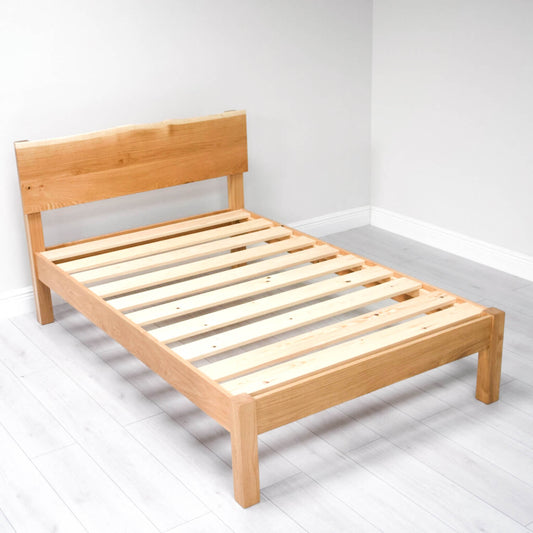Wood is a commonly used material in furniture production, especially when it comes to bed frames. There are many reasons for this, which mainly revolve around durability, style, and comfort. We’re big fans of wood – it’s our namesake, after all.
There are so many different types of wooden beds. You can choose from a vast range of wood options, finishes, and bed sizes. With so much choice, it can quickly become hard to keep track of. To help you learn more about the world of wooden beds, we’ve developed this in-depth buying guide.
We’ll cover everything a prospective buyer should consider in the buying process. From size to style, and even the material possibilities, this wooden bed buying guide has it all.
Types of Wooden Beds
With its high versatility, wood can be designed, shaped, and styled in a variety of different bed frame types. This covers most standard bed frame designs, like platform beds, ottoman beds, and four poster beds.
Platform Beds

Pictured: Model 02 - Wooden Platform Bed, No Headboard
Platform beds are characterised by their sleeping area being raised off the ground via tall legs. This opens up the underside of the frame to enable greater storage facilities, as well as light and air flow.
Ottoman Beds
Pictured: Model 05 - Wooden Ottoman Bed
Wooden ottoman beds feature a hidden storage compartment underneath the mattress. This area is perfect for keeping your extra bedding, duvets, pillows and clothes neat, organised, yet accessible.
Four Poster Beds
Pictured: Model 06 - Four Poster Wooden Bed
Four poster beds (also sometimes called canopy beds) have a traditional design. These beds are characterised by their four raised posts at the four corners of the frame. They’re statement pieces through and through, with a larger-than-life profile that dominates any room they’re placed in.
Wooden Bed Materials
The wood used for beds not only needs to last a long time, but be stylish too. It should look as great as the day you bought it – or as close to this as possible.
We primarily use two different types of wood in our bed frames: European oak or Scandinavian pine.
European Oak
When we say a lifetime of use, with European oak, we mean it. European oak grows slowly and offers exceptional strength thanks to its dense grain. If properly cared for and maintained, beds made from this resilient hardwood should last for several years.
You can find European oak used across our entire oak bed range, which comprises low wooden beds, standard height bed frames, and everything in between.
Scandinavian Pine
Scandinavian pine is a frequent substitute for European oak. While pine isn’t generally considered to be as strong as oak (due to the faster growing process), we confidently stand by its effectiveness and offer a 12-year structural guarantee on the components in our bed frames.
Should I Buy a Bed With or Without a Headboard?
Most people have a headboard, but sometimes, you may forego one after considering your sleep preferences, furniture tastes, and space restrictions.
Platform beds, for example, can often be found without a headboard. This makes them especially useful in rooms where vertical space comes at a premium, such as a loft or attic conversion.
Though, the choice of whether to have a headboard doesn’t have to be bound to practicalities. Some people prefer a minimalistic look.
How to Maintain a Wooden Bed
While the use of strong types of wood will generally keep your bed frame functioning for many years, some extra care and cleaning can help extend this for even longer.
Wipe It Down: Wood is an absorbent material. While some treatments can be applied to make them more resistant to accidental spills and splashes, this can alter the way your bed frame is cleaned. Keeping yours clean should involve little more than an occasional wipe down with a damp, but not sodden, cloth.
Avoid Excess Humidity: When wet (or even just damp), wood can expand as it soaks up the excess moisture. This means that humid rooms, such as those with ensuites, can see their wooden beds swell over time, impacting the original manufacturing tolerances, which eventually leads to cracking. Keep your bedroom well-ventilated to forego furniture fuss.
Keep It Protected: Bed frames are heavy, bulky pieces of furniture. But, sometimes, they need to be moved. So, consider placing felt protective pads underneath the legs. These will not only make it easier for the bed to be moved, but they can also protect your precious floor underneath.
Correct Assembly: When you buy with us, your bed frame will arrive flat-packed. This means some self-assembly is required. Over time, the bolts and screws used to keep the frame together may loosen and will need to be tightened.
Make sure you check these every few months and give them a quick tighten when needed. For any major damage, contact us, and we’ll see how we can help.
How to Choose Your Next Wooden Bed
Here are the top three things to think about when choosing your next bed:
1. Bed size
Mattresses have standard dimensions, and beds will be built around them. However, depending on the style and material used, some frames can be taller or bulkier than others.That’s why it’s important to know how much space your frame will take up before you commit.
Before deciding on a particular style, take accurate measurements of your room. Once you have them on hand, cross-reference them with the dimensions of your bed of choice. Ideally, you’ll want your bed to take up no more than 30% of your room’s overall size and allow space for bedside tables.
2. Storage Needs:
For some, comfort and style are highly important. For others, storage is a bigger concern. If you find yourself in the latter camp, make sure you evaluate this while shopping around.
If you’re only storing small items like clothes or shoes, your needs will be much smaller compared to those looking to store things like bedding or extra sheets.
3. Slat Position:
When buying with us, you can choose whether your slats are level with the sides of the bed or recessed deep within the sleeping platform. The former raises the mattress slightly higher, making it easier to put fitted or flat sheets. The latter lowers the bed frame slightly, giving a sunken appearance.
How Long Do Wooden Beds Last?
As a vote of confidence, we offer a 12-year structural guarantee on every wooden bed we sell. With proper maintenance, though, there’s nothing preventing your wooden bed frame lasting significantly longer than this.
The durability of your bed will largely depend on the quality of the materials used, and we pride ourselves on only using the finest quality hardwood and pine available. This, combined with tried and tested carpentry methods like mortise and tenon joints ensures the longevity of each of our wooden beds.
Are Wooden Beds Easy to Assemble?
Wood is a very workable material. It’s highly repairable and easily assembled into a finished product.
Every bed we sell will arrive flat-packed with detailed instructions for assembly. Building your bed is easy and should take you no more than 1-2 hours with the right tools.
Don’t worry, you don’t need to be a qualified carpenter to build a wooden bed. Our clever DIY system means that you can assemble your bed frame in as little as 20 minutes.
Find out more about the other benefits of wooden beds in our guide: What Are The Advantages Of Wooden Bed Frames?
Expertly Crafted Wooden Beds
Armed with your new-found wooden bed knowledge, now comes the time to make that all-important decision.
When you choose a quality wooden bed from us, you’ll benefit from our extensive woodworking expertise, a 12-year structural guarantee, and a choice of functional, stylish frames.
See our wooden beds range today and find the bed of your dreams.















